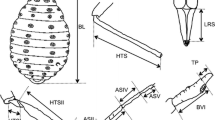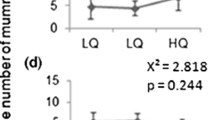Abstract
Inbreeding frequently reduces the fitness of organisms, but little is known about how this phenomenon can affect the biological control. Host fidelity provides an adaptive advantage to aphid parasitoids, allowing females to find their aphid host more quickly in heterogeneous environments. This trait is mediated by the learning of signals, mainly chemical cues emitted from the host in which parasitoids developed (natal). This article is aimed at studying whether host fidelity can be altered after many generations of inbreeding reproduction in caged laboratory populations, for which host preference and fitness parameters were measured in the parasitoid wasp Aphidius ervi. Also, the effect of the natal/non-natal hosts was studied, using parasitoids originated from the pea aphid (Acyrthosiphon pisum) and the grain aphid (Sitobion avenae). We observed a loss of host fidelity in the studied A. ervi populations, irrespective of their natal aphid host, which contrasts with previous reports showing preference for natal hosts in outbred laboratory populations. The loss of host fidelity is discussed in terms of the origin of populations; the sex ratio was strongly biased toward males and long-time maintenance under laboratory conditions. Our results highlight the need for controlling the genetic diversity of caged parasitoids before they are released into fields, as a long period of inbreeding could negatively affect the biological control.




Similar content being viewed by others
References
Antolin MF (1999) A genetic perspective on mating systems and sex ratios of parasitoid wasps. Res Popul Ecol (Kyoto) 41:29–37. doi:10.1007/PL00011979
Antolin MF, Bjorkstena TA, Vaughn TT (2006) Host-related fitness trade-offs in a presumed generalist parasitoid, Diaeretiella rapae (Hymenoptera: Aphidiidae). Ecol Entomol 31:242–254. doi:10.1111/j.1365-2311.2006.00769.x
Bates DM (2010) Fitting linear mixed-effects models using lme4. J Stat Softw 67:1–48
Boivin G, Hance T, Brodeur J (2012) Aphid parasitoids in biological control. Can J Plant Sci 92:1–12. doi:10.4141/cjps2011-045
Bolker BM, Brooks ME, Clark CJ et al (2009) Generalized linear mixed models: a practical guide for ecology and evolution. Trends Ecol Evol 24:127–135. doi:10.1016/j.tree.2008.10.008
Boulton RA, Collins LA, Shuker DM (2015) Beyond sex allocation: the role of mating systems in sexual selection in parasitoid wasps. Biol Rev 90:599–627. doi:10.1111/brv.12126
Charlesworth D, Willis JH (2009) The genetics of inbreeding depression. Nat Rev Genet 10:783–796. doi:10.1038/nrg2664
Cook JM (1993) Sex determination in the Hymenoptera: a review of models and evidence. Heredity (Edinb) 71:421–435. doi:10.1038/hdy.1993.157
Cook JM, Crozier RH (1995) Sex determination and population biology in the Hymenoptera. Trends Ecol Evol 10:281–286
Damiens D, Boivin G (2006) Why do sperm-depleted parasitoid males continue to mate? Behav Ecol 17:138–143. doi:10.1093/beheco/arj009
Daza-Bustamante P, Fuentes-Contreras E, Rodriguez LC, Figueroa CC, Niemeyer HM (2002) Behavioural differences between Aphidius ervi populations from two tritrophic systems are due to phenotypic plasticity. Entomol Exp Appl 104:321–328
De Rijk M, Dicke M, Poelman EH (2013) Foraging behaviour by parasitoids in multiherbivore communities. Anim Behav 85:1517–1528. doi:10.1016/j.anbehav.2013.03.034
Figueroa CC, Simon JC, Le Gallic JF, Prunier-Leterme N, Briones LM, Dedryver CA, Niemeyer HM (2004) Effect of host defense chemicals on clonal distribution and performance of different genotypes of the cereal aphid Sitobion avenae. J Chem Ecol 30:2515–2525. doi:10.1007/s10886-004-7947-x
Gandolfi M, Mattiacci L, Dorn S (2003) Mechanisms of behavioral alterations of parasitoids reared in artificial systems. J Chem Ecol 29:1871–1887. doi:10.1023/A:1024854312528
Geden CJ, Smith L, Long SJ, Rutz DA (1992) Rapid deterioration of searching behavior, host destruction, and fecundity of the parasitoid Muscidifurax-Raptor (Hymenoptera, Pteromalidae) in culture. Ann Entomol Soc Am 85:179–187
Giunti G, Canale A, Messing RH et al (2015) Parasitoid learning: current knowledge and implications for biological control. Biol Control 90:208–219. doi:10.1016/j.biocontrol.2015.06.007
Godfray HCJ (1994) Parasitoids: behavioral and evolutionary ecology. Princeton University Press, Princeton
Grenier S, De Clerq P (2003) Comparison of artificially versus naturally reared natural enemies and their potential use in biological control. In: van Lenteren JC (ed) Quality control and production of biological control agent. CAB International, Wallingford, pp 115–131
Harrison XA (2014) Using observation-level random effects to model overdispersion in count data in ecology and evolution. PeerJ 2:e616. doi:10.7717/peerj.616
He XZ, Wang Q (2008) Reproductive strategies of Aphidius ervi Haliday (Hymenoptera: Aphidiidae). Biol Control 45:281–287. doi:10.1016/j.biocontrol.2008.03.003
Henry LM, Gillespie DR, Roitberg BD (2005) Does mother really know best? Oviposition preference reduces reproductive performance in the generalist parasitoid Aphidius ervi. Entomol Exp Appl 116:167–174. doi:10.1111/j.1570-7458.2005.00318.x
Henry LM, Roitberg BD, Gillespie DR (2008) Host-range evolution in Aphidius parasitoids: fidelity, virulence and fitness trade-offs on an ancestral host. Evolution 62:689–699. doi:10.1111/j.1558-5646.2007.00316.x
Henry LM, May N, Acheampong S et al (2010) Host-adapted parasitoids in biological control: does source matter? Ecol Appl 20:242–250
Henter HJ (2003) Inbreeding depression and haplodiploidy: experimental measures in a parasitoid and comparisons across diploid and haplodiploid insect taxa. Evolution 57:1793–1803. doi:10.1554/02-751
Hothorn TF, Bretz P, Westfall P, Heiberger RM (2008) Multcomp: simultaneous inference in general parametric models. http://CRAN.R-project.org. R package version 1.0-0. Accessed on Oct 2015
Keller LF, Waller DM (2002) Inbreeding effects in wild populations. Trends Ecol Evol 17:230–241
Luna M, Hawkins B (2004) Effects of inbreeding versus outbreeding in Nasonia vitripennis (Hymenoptera: Pteromalidae). Environ Entomol 33:765–775. doi:10.1603/0046-225X-33.3.765
Niemeyer HM (2009) Hydroxamic acids derived from 2-hydroxy-2 H-1, 4-benzoxazin-3 (4 H)-one: key defense chemicals of cereals. J Agric Food Chem 57:1677–1696
Ode PJ, Antolin MF, Strand MR (1997) Constrained oviposition and female-biased sex allocation in a parasitic wasp. Oecologia 109:547–555
Oliver KM, Campos J, Moran NA, Hunter MS (2008) Population dynamics of defensive symbionts in aphids. Proc Biol Sci 275:293–299. doi:10.1098/rspb.2007.1192
Ottoni EB (2000) EthoLog 2.2: a tool for the transcription and timing of behavior observation sessions. Behav Res Methods Instrum 32:446–449
Peakall R, Smouse PE (2012) GenALEx 6.5: genetic analysis in Excel. Population genetic software for teaching and research-an update. Bioinformatics 28:2537–2539. doi:10.1093/bioinformatics/bts460
Peccoud J, Bonhomme J, Mahéo F et al (2013) Inheritance patterns of secondary symbionts during sexual reproduction of pea aphid biotypes. Insect Sci 21:291–300. doi:10.1111/1744-7917.12083
Peccoud J, Huerta M, Bonhomme J, Laurence C, Outreman Y, Smadja CM, Simon JC (2014) Widespread host-dependent hybrid unfitness in the pea aphid species complex. Evolution 68:2983–2995. doi:10.1111/evo.12478
R Core Team (2012) R: a language and environment for statistical computing. R Foundation for Statistical Computing, Vienna
Roush RT (1990) Genetic considerations in the propagation of entomophagous species. In: Baker RR, Dunn PE (eds) New directions in biological control: alternatives for suppressing agricultural pests and disease. Plenum Press, New York, pp 373–387
Salin C, Deprez B, Van Bockstaele DR et al (2004) Sex determination mechanism in the hymenopteran parasitoid Aphidius rhopalosiphi De Stefani-Peres (Braconidae: Aphidiinae). Belg J Zool 134:15–21
Schwörer U, Völkl W (2001) Foraging behavior of Aphidius ervi (Haliday) (Hymenoptera: Braconidae: Aphidiinae) at different spatial scales: resource utilization and suboptimal weather conditions. Biol Control 21:111–119. doi:10.1006/bcon.2001.0931
Sepúlveda DA, Zepeda-Paulo F, Ramírez CC, Lavandero B, Figueroa CC (2016) Diversity, frequency and geographic distribution of facultative bacterial endosymbionts in introduced aphid pests. Insect Sci. doi:10.1111/1744-7917.12313
Starý P (1995) The Aphidiidae of Chile (Hymenoptera, Ichneumonoidea, Aphidiidae). Dtsch Entomol Zeitschrift 42:113–138
Storeck A, Poppy GM, Emden HF, Powell W (2000) The role of plant chemical cues in determining host preference in the generalist aphid parasitoid Aphidius colemani. Entomol Exp Appl 97:41–46. doi:10.1046/j.1570-7458.2000.00714.x
Stouthamer R, Luck RF, Werren JH (1992) Genetics of sex determination and the improvement of biological control using parasitoids. Environ Entomol 21:427–435
Therneau TM (1999) A package for survival analysis in statistical technical report. Mayo Foundation. http://www.mayo.edu/hsr/people/therneau/survival
Tien NSH, Sabelis MW, Egas M (2014) Inbreeding depression and purging in a haplodiploid: gender-related effects. Heredity (Edinb) 114:327–332. doi:10.1038/hdy.2014.106
Torvik MM (1931) Genetic evidence for diploidsm of biparental males in Habrobracon. Biol Bull 61:139–156
Tumlinson J, Lewis W, Vet L (1993) How parasitic wasps find their hosts. Sci Am 268:100–106
Unruh TR, White W, Gonzalez D, Gordh G, Luck RF (1983) Heterozygosity and effective size in laboratory populations of Aphidius ervi [Hym.: Aphidiidae]. Entomophaga 28:245–258
Van Lenteren JC (2003) Quality control and production of biological control agents. CABI, Cambridge
Vayssade C, De Fazio C, Quaglietti B et al (2014) Inbreeding depression in a parasitoid wasp with single-locus complementary sex determination. PLoS One 9:1–8. doi:10.1371/journal.pone.0097733
Völkl W (1994) Searching at different spatial scales: the foraging behaviour of the aphid parasitoid Aphidius rosae in rose bushes. Oecologia 100:177–183. doi:10.1007/BF00317144
Weinbrenner M, Völkl W (2001) Oviposition behaviour of the aphid parasitoid, Aphidius ervi: are wet aphids recognized as host? Entomol Exp Appl 103:51–59. doi:10.1023/A:1019841517467
Werren JH (1993) The evolution of inbreeding in haplodiploid organisms. In: Thornhill NW (ed) The natural history of inbreeding and outbreeding. Theoretical and empirical perspectives. The University of Chicago Press, Chicago
Zepeda-Paulo F, Ortiz-Martínez S, Figueroa CC, Lavandero B (2013) Adaptive evolution of a generalist parasitoid: implications for the effectiveness of biological control agents. Evol Appl 6:983–999. doi:10.1111/eva.12081
Zepeda-Paulo F, Lavandero B, Mahéo F et al (2015) Does sex-biased dispersal account for the lack of geographic and host-associated differentiation in introduced populations of an aphid parasitoid? Ecol Evol 5:2149–2161. doi:10.1002/ece3.1504
Zhou Y, Gu H, Dorn S (2007) Effects of inbreeding on fitness components of Cotesia glomerata, a parasitoid wasp with single-locus complementary sex determination (sl-CSD). Biol Control 40:273–279. doi:10.1016/j.biocontrol.2006.11.002
Acknowledgments
The authors thank Angélica González, Gabriel Ballesteros, and Sebastián Ortíz for helping us in aphid and parasitoid rearing and data analysis and with advice on parasitoid biology and species determinations. DAS thanks to Iniciativa Científica Milenio grant NC120027 for a fellowship. Also, we thank the valuable comments made by anonymous referees.
Funding
This study was funded by FONDECYT (Grant Number 1130483 to CCF).
Author information
Authors and Affiliations
Corresponding author
Ethics declarations
Conflict of Interest
Authors declare no conflict of interest.
Ethical approval
All applicable international, national, and/or institutional guidelines for the care and use of animals were followed.
Additional information
Communicated by M. Traugott.
Rights and permissions
About this article
Cite this article
Sepúlveda, D.A., Zepeda-Paulo, F., Ramírez, C.C. et al. Loss of host fidelity in highly inbred populations of the parasitoid wasp Aphidius ervi (Hymenoptera: Braconidae). J Pest Sci 90, 649–658 (2017). https://doi.org/10.1007/s10340-016-0798-8
Received:
Revised:
Accepted:
Published:
Issue Date:
DOI: https://doi.org/10.1007/s10340-016-0798-8




